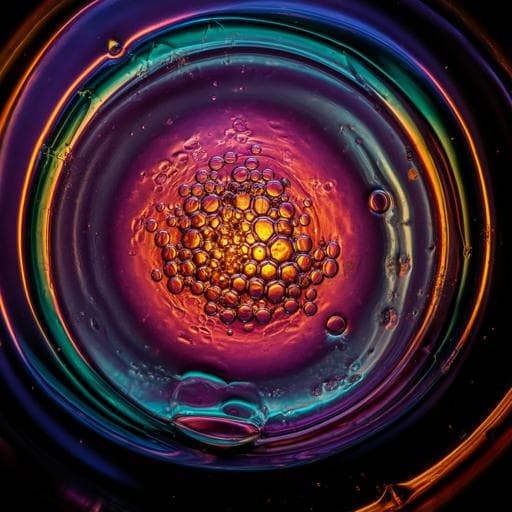
Chemistry
Effect of structural disorder induced by external irradiation with heavy ions on the alteration of a four oxide borosilicate glass
S. Gin, M. Taron, et al.
This groundbreaking study by Stéphane Gin, Mélanie Taron, Hélène Arena, and Jean-Marc Delaye explores how 7 MeV Au ion irradiation impacts a model nuclear glass. Remarkably, they found that irradiation significantly accelerates the interdiffusion and dissolution rates, while revealing intriguing structural changes through Raman spectroscopy.
~3 min • Beginner • English
Introduction
Borosilicate glasses are used to immobilize fission products from used nuclear fuels for deep geological disposal. Water-driven alteration governs radionuclide release and proceeds through interdiffusion/ion-exchange and network hydrolysis, with an initial dissolution regime followed by a residual dissolution regime controlled by solution affinity and the formation of a passivating gel. While mechanistic understanding comes largely from non-radioactive surrogate glasses, the impact of self-irradiation-induced structural damage on alteration remains less explored. External heavy-ion irradiation can simulate key ballistic effects of self-irradiation and is known to modify glass structure (e.g., density, boron coordination, mechanical properties). Prior studies reported mixed effects on interdiffusion and initial dissolution rates depending on composition and complexity. This study examines how 7 MeV Au-ion irradiation modifies the alteration behavior of a simplified 4-oxide borosilicate glass (CJ2) across interdiffusion, initial dissolution, and residual regimes, to identify which atomic-scale reactions limit dissolution and how structural disorder affects kinetics.
Literature Review
- Established dissolution phenomenology: In dilute media, initial rates reflect network hydrolysis without feedback; residual rates arise from reduced affinity due to solution enrichment and passivating gel formation; destabilization can occur via secondary phase precipitation.
- Interdiffusion precedes initial rate in acidic media, driven by H+/H3O+ exchange with modifiers and boron hydrolysis; reaction importance depends on NBO content and pH; interdiffusion scales with square root of time.
- Residual rate controls remain debated and composition/condition dependent; can involve water diffusion triggering ion exchange, B hydrolysis from the network, transport through the gel, or secondary precipitation.
- Irradiation effects: Self-irradiation causes ballistic/electronic damage, density variations, changes in B coordination, hardness, and toughness. External heavy-ion irradiation is a common surrogate though not fully equivalent to self-irradiation. Prior works show increased interdiffusion and initial dissolution in some simple borosilicates, negligible effects in more complex glasses. Faster quenching (structural disorder) also slightly increases initial and residual rates.
- For borosilicate glasses with sufficient B content (e.g., ISG-like), residual rate in near-silica-saturation conditions can be limited by B–O–Si bond hydrolysis when these bonds percolate through the network; in basic dilute media, initial rate is controlled by Si–O–Si hydrolysis.
- High-energy ions (e.g., 1 GeV Xe) can form ion tracks that enhance reactivity; alpha emitters in real glass do not create tracks due to insufficient energy.
Methodology
Glass: CJ2 composition 64.9 SiO2, 17.3 B2O3, 13.6 Na2O, 4.1 Al2O3 (mol%). Prepared from analytical-grade precursors, melted twice at 1500°C and 1450°C, annealed 3 h at Tg + 20 K (530°C). Composition verified by ICP-OES. 48 ± 2% fourfold-coordinated B by NMR, giving NBO fraction of 0.037 per (Si+Al) tetrahedron. Monoliths were cut and polished to 0.05 µm, surface roughness a few nm.
Irradiation: Monoliths irradiated on both large faces with 7 MeV Au3+ ions (2MV Aramis accelerator, SCALP facility, CNRS-CSNSM, Orsay, France). Fluence 2 × 10^16 at·cm^-2, inducing ~40 MGy minimum nuclear dose over ~1.8 µm depth; Au implantation range ~2 µm (SRIM), confirmed by ToF-SIMS. Damaged zone thickness ~1.8–2 µm.
Raman spectroscopy: Horiba Jobin Yvon XploRA Plus, 532 nm excitation, 1800 g·mm^-1 grating; backscattering perpendicular to surface; confocal hole 100 µm (probing first ~2 µm); 15 accumulations × 240 s at identical position/conditions for pristine and irradiated surfaces.
Interdiffusion experiments: PFA vessels with 40 mL 18.2 MΩ·cm water at 30 ± 1°C; pH adjusted to 1 ± 0.1 with 1 M HNO3; ~0.1 M KCl added as exogenous K tracer for ToF-SIMS. Two coupons per reactor (non-irradiated and irradiated): withdrawn after 8 h and 3 days. Upon retrieval, coupons rinsed (DI water) and dried at 50°C. After 3 days, 2 mL solution sampled and acidified; Si, B, Na, Al analyzed by ICP-OES to confirm negligible network dissolution.
Initial dissolution rate experiments: PFA vessels with 500 mL water at 90 ± 1°C; pH 9 ± 0.1 adjusted with 0.1 M LiOH. Coupons (irradiated only on two large faces; non-irradiated control of similar size) were cleaned, placed in PFA basket, and suspended; magnetic stirring ensured turbulent flow (Re > 2000). Periodic 2 mL samplings over 3.3 days (non-irr) and 1.3 days (irr). Elemental concentrations by ICP-OES; normalized mass loss NL(i) in g·m^-2 computed as NL(i) = 10^-2·C(i)·V/(S·Xi). Equivalent altered thickness ETh(i) = NL(i)/ρe. Initial rate r0 = d(NL(i))/dt; uncertainty ±30%. For irradiated coupon, r0 corrected for unirradiated side area fraction f using Corrected r0,irr = [r0,irr − f·r0,non-irr]/(1 − f).
Residual rate experiments: Static mode at 90 ± 1°C, pH 9 ± 0.1, near-silica-saturation (~80% of amorphous silica saturation) and H2^18O-enriched solution. Two coupons per reactor; experimental parameters: Non-irr sample S/V ≈ 0.08 cm^-1, Co(Si) ≈ 286 mg·L^-1; Irr sample S/V ≈ 0.52 cm^-1, Co(Si) ≈ 257 mg·L^-1. Durations: 563 days (non-irr) and 133 days (irr). B release used to compute equivalent altered thickness vs time.
ToF-SIMS: IONTOF TOF.5 (TESCAN Analytics, France) in abrasion-analysis mode; charge neutralization by low-energy electrons (<20 eV). Depth calibration by crater profilometry. Interdiffusion profiles: O2− sputter; Bi+ analysis; residual-rate profiles: Cs+ sputter; Bi+ analysis; cryogenic ToF-SIMS for tracer retention of pore water. Intensities normalized to pristine glass; isotopic ratios (^18O/^16O, ^11B/^10B) corrected to match natural abundance in pristine regions. Additional 24 h tracing in ^18O- and ^10B-enriched solution prior to cryo ToF-SIMS to probe tracer incorporation kinetics.
Key Findings
- Structural modifications (Raman):
- R-band (~480 cm^-1) shifted +10 cm^-1 after irradiation, indicating decreased average Si–O–Si angle.
- Q″ band (850–1200 cm^-1) intensity increased at shorter wavelengths, evidencing silicate network depolymerization in irradiated glass.
- D2 band (~600 cm^-1) intensity increased, suggesting more three-membered rings and broader ring-size distribution.
- Band at ~770 cm^-1 changed, consistent with altered borate ring populations and likely reduced BO4 fraction (BIV). Based on analogous ISG irradiation, BIV fraction may drop from ~50% to ~36%, increasing NBO from 0.037 to ~0.1 per (Si+Al) tetrahedron.
- BO3 stretching band (1300–1550 cm^-1) increased, especially near 1450 cm^-1 (BO3 linked to NBO), indicating increased BO3/BO4 and NBO after irradiation.
- Interdiffusion at 30 °C, pH 1 (with ~0.1 M KCl):
- Solution after 3 days (irradiated): Na and B equivalent altered thickness 1.1 ± 0.1 µm; Si < 0.1 ppm (dissolved thickness < 2 nm) → network dissolution negligible.
- ToF-SIMS thickness of alteration layer: non-irr 18 nm (8 h) → 38 nm (3 d); irradiated 145 nm (8 h) → 1300 nm (3 d).
- Enhancement vs non-irr: ~×8 (8 h) and ~×34 (3 d).
- B and Na depletion fronts nearly congruent; H profiles anticorrelated with B, Na. Thin Al-depleted outer layer (~5–10 nm). Conclusion: B–O–Si bond hydrolysis is rate-limiting for interdiffusion, enabling water ingress and Na/H3O+ exchange.
- Initial dissolution rate at 90 °C, pH 9 (dilute, stirred):
- Linear, congruent dissolution for Si, B, Na, Al at early times (first 0.4 day used for r0).
- r0 (from Si): non-irr 4.7 ± 1.4 g·m^-2·d^-1; irradiated 10.9 ± 3.3 g·m^-2·d^-1 → factor 2.3 increase (±30% uncertainty).
- Residual regime at 90 °C, pH 9, near silica saturation:
- Non-irr: slow alteration for ~200 days, then cessation/below detection; gel thickness by ToF-SIMS 1.5 ± 0.15 µm; solution-derived altered thickness 1.1 ± 0.55 µm.
- Irradiated: alteration progressed up to 133 days (test stopped when altered thickness exceeded irradiated depth); solution-derived altered thickness 4.5 ± 0.9 µm; ToF-SIMS gel thickness 3.8 ± 0.4 µm. Au detected to 2.1 ± 0.2 µm consistent with 2 µm SRIM.
- Gel isotopic signatures: irradiated gel shows higher ^18O incorporation and steeper internal ^18O/^16O gradient (Δ ≈ 7×10^-5 d^-1) vs non-irr (≈ 5×10^-5 d^-1), indicating faster hydrolysis/condensation. Slightly lower B retention near interface for irradiated gel (5%) vs non-irr (10%).
- Tracing (24 h, ^18O and ^10B):
- No change in gel thickness; slight increase in ^18O/^16O near exterior, more pronounced for non-irr gel outer zone.
- ^10B penetration limited to outer ~300–400 nm in both gels; ^10B does not reach gel/glass interface within 24 h, consistent with very low B diffusivity (~10^-21 m^2·s^-1 reported for ISG gels).
Discussion
Irradiation-induced structural disorder enhances glass reactivity across regimes but with regime-dependent magnitude. In acidic interdiffusion conditions, alteration thickness and congruent B/Na leaching increase by more than an order of magnitude for irradiated glass, pointing to accelerated hydrolysis of B–O–Si linkages that opens pathways for water ingress and Na/H3O+ exchange. Possible contributing factors include irradiation-induced swelling (free volume increase; ~1.7% swelling reported for similarly irradiated ISG), isotopic/coordination changes (greater fraction of species that dissolve faster), and higher stored energy.
In basic dilute environments (initial rate), dissolution is governed by Si–O–Si bond hydrolysis. The observed ~2.3× increase in r0 for the irradiated glass likely reflects medium-range structural changes (more small rings which are less stable) rather than only the change in B speciation/NBO, which simulations suggest would yield only a small rate change on its own. More complex glasses that do not form additional small rings under irradiation show little to no change in initial rate, supporting this structural interpretation.
Under residual conditions near silica saturation, Si–O–Si hydrolysis is strongly suppressed by solution affinity; dissolution is then controlled by processes involving B–O–Si hydrolysis and gel formation/reorganization. Although irradiated glass shows a larger altered thickness at a given time, the difference versus non-irradiated glass is smaller than in interdiffusion conditions. ToF-SIMS and isotopic data indicate that gels from irradiated glass are initially more disordered (inherit glass structure) but also undergo faster hydrolysis–condensation reorganization (higher ^18O incorporation rate), which enhances passivation development and limits the long-term difference in residual rate. The lower interfacial B retention (5% vs 10%) also suggests gel from non-irradiated glass is slightly more passivating at late times. The greater-than-expected alteration beyond the 2 µm irradiated zone hints at mechanical/chemical coupling, such as stress effects from the overlying gel affecting underlying pristine glass.
Overall, irradiation primarily accelerates kinetics without changing the identity of rate-limiting reactions: B–O–Si hydrolysis limits both interdiffusion and the early residual regime (for B-rich glasses and pH 7–9), while Si–O–Si hydrolysis limits the initial rate in basic dilute media. The absence of ion-track formation for 7 MeV Au (unlike 1 GeV Xe) constrains the extent of reactivity enhancement compared to track-forming irradiations.
Conclusion
External 7 MeV Au-ion irradiation of a simplified borosilicate (CJ2) induces structural disorder (reduced Si–O–Si angles, depolymerization, more small rings, increased BO3 and NBO) that significantly accelerates alteration kinetics. The strongest impact is on acidic interdiffusion, where alteration layer growth increases by factors of ~8 (8 h) to ~34 (3 d) relative to non-irradiated glass, consistent with B–O–Si hydrolysis as the limiting mechanism. In basic dilute conditions, the initial dissolution rate rises by ~2.3×, likely due to increased susceptibility of medium-range structural motifs (small rings) to hydrolysis of Si–O–Si bonds. In near-silica-saturation residual conditions, irradiated glass alters more than the control, but gels formed on irradiated glass also reorganize faster (greater ^18O incorporation), which mitigates the long-term impact on residual rate. Thus, irradiation changes kinetics but not the fundamental limiting reactions across regimes. Future work should examine the coupled dynamics of damage creation and gel reorganization under simultaneous alpha-decay damage and corrosion, and clarify how stress and structural inheritance from damaged zones influence passivation and long-term durability.
Limitations
- External heavy-ion irradiation (single, unidirectional 7 MeV Au) is not a perfect surrogate for complex, isotropic self-irradiation from alpha decay; ion-track formation does not occur at 7 MeV Au, unlike higher-energy ions (e.g., 1 GeV Xe), potentially limiting generality.
- Only one simplified glass composition (CJ2) was tested; results may differ for more complex nuclear glasses or for glasses with lower B content where Si–O–B bonds may not percolate.
- Residual-rate experiments used different S/V between irradiated and non-irradiated tests; although argued not impactful at near-saturation, it introduces potential comparability uncertainty.
- Irradiated CJ2 density change was not measured; some interpretations (e.g., swelling, free-volume effects) are inferred from analogous ISG data.
- Structural modifications beyond the 2 µm irradiated depth are uncertain; greater alteration observed past this depth suggests additional mechanisms (e.g., gel-induced stresses) requiring further study.
- Uncertainties: ±30% on initial rate; gel thickness estimates by ToF-SIMS assume similar sputter rates for gel and glass; B speciation and diffusivity in gels remain poorly constrained.
Related Publications
Explore these studies to deepen your understanding of the subject.







